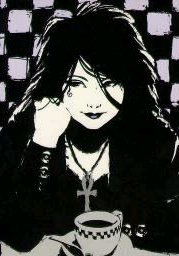This article has multiple issues. Please help improve it or discuss these issues on the talk page. (Learn how and when to remove these messages)
|
| Death of the Endless | |
|---|---|
 Death, as seen in promotional art for Death: The Time of Your Life #1 (April 1996). Art by Chris Bachalo. | |
| Publication information | |
| Publisher | DC Comics |
| First appearance | The Sandman vol. 2, #8 (August 1989) |
| Created by | Neil Gaiman (writer) Mike Dringenberg (artist) |
| In-story information | |
| Team affiliations | The Endless |
Death of the Endless is a fictional personification of death who appears in American comic books published by DC Comics. She first appeared in The Sandman vol. 2, #8 (August 1989) and was created by Neil Gaiman and Mike Dringenberg.[1]
In the DC Universe continuity, Death is both the end of life and a psychopomp. Like most personifications of death, Death meets with the recently deceased and guides them into their new existence. Unlike most personifications of death, she also visits people as they are born, according to Destruction in the Sandman Special: The Song of Orpheus. Evidently, only she seems to remember these encounters. In the special issue, it is also revealed that Death was known in ancient Greece as Teleute.
Physically, Death is also opposite to the traditional western culture personification of death, the Grim Reaper. In The Sandman, Death instead appears as an attractive, pale goth girl dressed in casual clothes — often a black top and jeans. She also wears a silver ankh on a chain around her neck, and has a marking similar to the eye of Horus around her right eye.[2] She is pleasant, kind, down-to-earth, perky, and has been a nurturing figure for both incarnations of Dream. This irony has helped make Death one of the most popular characters from Sandman. Death was named the fifteenth greatest comic book character by Empire.[3]
Kat Dennings voices the character in Audible's The Sandman (2019), while Kirby[a] portrays the character in the Netflix series The Sandman (2022–present) and Dead Boy Detectives (2024–present).[5][6]
- ^ Irvine, Alex (2008), "Death", in Dougall, Alastair (ed.), The Vertigo Encyclopedia, New York: Dorling Kindersley, pp. 54–56, ISBN 978-0-7566-4122-1, OCLC 213309015
- ^ Cite error: The named reference
dc-encywas invoked but never defined (see the help page). - ^ "Empire | The 50 Greatest Comic Book Characters". Empireonline.com. 2006-12-05.
- ^ Spilde, Coleman (2024-03-09). "The Disappointing 'We Strangers' Keeps Outsiders at a Distance". The Daily Beast. Retrieved 2024-03-27.
- ^ Del Rosario, Alexandra (May 26, 2021). "'The Sandman': Kirby Howell-Baptiste, Mason Alexander Park & Donna Preston Among 12 Added To Netflix Series". Deadline Hollywood. Archived from the original on May 26, 2021. Retrieved May 26, 2021.
- ^ Bui, Hoai-Tran (May 26, 2021). "'The Sandman' Netflix Series Expands With 12 More Actors, Including Kirby Howell-Baptiste as Death". /Film. Retrieved May 26, 2021.
Cite error: There are <ref group=lower-alpha> tags or {{efn}} templates on this page, but the references will not show without a {{reflist|group=lower-alpha}} template or {{notelist}} template (see the help page).